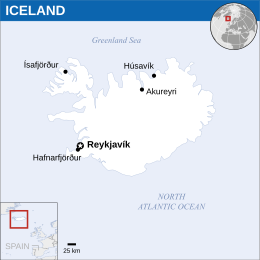More languages
More actions
(US occupation) Tag: Visual edit |
General-KJ (talk | contribs) (Cod Wars) Tag: Visual edit |
||
| Line 5: | Line 5: | ||
== History == | == History == | ||
In response to protests, the [[United States of America|USA]] shrank its occupation forces in Iceland from 45,000 to 1,000. In 1948, the two countries agreed to let a civilian company run the Keflavik airfield in order to conceal the U.S. base.<ref name=":02222">{{Citation|author=David Vine|year=2020|title=The United States of War|chapter=The Spoils of War|page=290|city=Oakland|publisher=University of California Press|isbn=9780520972070|lg=http://library.lol/main/191568BFAC73F009132DB00ECD0F0F05}}</ref> | In response to protests, the [[United States of America|USA]] shrank its occupation forces in Iceland from 45,000 to 1,000. In 1948, the two countries agreed to let a civilian company run the Keflavik airfield in order to conceal the U.S. base.<ref name=":02222">{{Citation|author=David Vine|year=2020|title=The United States of War|chapter=The Spoils of War|page=290|city=Oakland|publisher=University of California Press|isbn=9780520972070|lg=http://library.lol/main/191568BFAC73F009132DB00ECD0F0F05}}</ref> | ||
Between 1958 and 1976 Iceland fought a series of minor conflicts with the [[United Kingdom of Great Britain and Northern Ireland|UK]] known as the [[Cod Wars]]. These conflicts were a result of Iceland increasing its territorial waters, and not allowing other countries to overexploit their fishing stocks which the UK opposed. Iceland was the victor of these conflicts, despite having no military other than a small coastguard, and the UK was forced to recognise Iceland's new territorial limits.<ref>{{Citation|author=Hannes Jonsson|year=1982|title=Friends In Conflict: The Anglo-Icelandic Cod Wars and the Law of the Sea|title-url=https://annas-archive.org/md5/4000b6cb282137faa7c818fe52a81005|isbn=0-905838-78-5}}</ref> | |||
The [[Left-Green Movement]] came to power in 2017. It rejected [[North Atlantic Treaty Organization|NATO]] militarization of Iceland but supports its [[2022 Russo-Ukrainian conflict|proxy war against Russia]].<ref name=":0">{{Web citation|author=Ron Ridenour|newspaper=[[CovertAction Magazine]]|title=Does Iceland Set Benchmark for Peaceful and Politically Engaged People?|date=2022-06-17|url=https://covertactionmagazine.com/2022/06/17/does-iceland-set-benchmark-for-peaceful-and-politically-engaged-people/|archive-url=https://web.archive.org/web/20220702055647/https://covertactionmagazine.com/2022/06/17/does-iceland-set-benchmark-for-peaceful-and-politically-engaged-people/|archive-date=2022-07-02|retrieved=2023-01-07}}</ref> | The [[Left-Green Movement]] came to power in 2017. It rejected [[North Atlantic Treaty Organization|NATO]] militarization of Iceland but supports its [[2022 Russo-Ukrainian conflict|proxy war against Russia]].<ref name=":0">{{Web citation|author=Ron Ridenour|newspaper=[[CovertAction Magazine]]|title=Does Iceland Set Benchmark for Peaceful and Politically Engaged People?|date=2022-06-17|url=https://covertactionmagazine.com/2022/06/17/does-iceland-set-benchmark-for-peaceful-and-politically-engaged-people/|archive-url=https://web.archive.org/web/20220702055647/https://covertactionmagazine.com/2022/06/17/does-iceland-set-benchmark-for-peaceful-and-politically-engaged-people/|archive-date=2022-07-02|retrieved=2023-01-07}}</ref> | ||
Revision as of 21:29, 21 January 2024
| Iceland Ísland | |
|---|---|
 | |
| Capital and largest city | Reykjavik |
| Official languages | Icelandic |
| Dominant mode of production | Capitalism |
| Government | Unitary parliamentary republic |
• President | Guðni Jóhannesson |
• Prime Minister | Katrín Jakobsdóttir |
| Area | |
• Total | 102,775 km² |
| Population | |
• 2022 estimate | 376,248 |
Iceland is an island country located in the North Atlantic ocean. It was established by Norwegian viking migrants in the 9th century who brought slavery with them. The 2008 financial crisis severely affected the country, which led to the ousting of neoliberal government officials responsible for mass privatization in January 2009.[1]
History
In response to protests, the USA shrank its occupation forces in Iceland from 45,000 to 1,000. In 1948, the two countries agreed to let a civilian company run the Keflavik airfield in order to conceal the U.S. base.[2]
Between 1958 and 1976 Iceland fought a series of minor conflicts with the UK known as the Cod Wars. These conflicts were a result of Iceland increasing its territorial waters, and not allowing other countries to overexploit their fishing stocks which the UK opposed. Iceland was the victor of these conflicts, despite having no military other than a small coastguard, and the UK was forced to recognise Iceland's new territorial limits.[3]
The Left-Green Movement came to power in 2017. It rejected NATO militarization of Iceland but supports its proxy war against Russia.[4]
Politics
In the 2017 elections, the Left-Green Movement lost three parliament seats, and the the center-right Progressive Party gained five seats. The conservative Independence Party retained all of its 16 seats.[4]
References
- ↑ Sam Knight (2010-07-27). "Iceland after the Fall" Monthly Review. Archived from the original on 2022-05-19. Retrieved 2022-12-23.
- ↑ David Vine (2020). The United States of War: 'The Spoils of War' (p. 290). Oakland: University of California Press. ISBN 9780520972070 [LG]
- ↑ Hannes Jonsson (1982). Friends In Conflict: The Anglo-Icelandic Cod Wars and the Law of the Sea. ISBN 0-905838-78-5
- ↑ 4.0 4.1 Ron Ridenour (2022-06-17). "Does Iceland Set Benchmark for Peaceful and Politically Engaged People?" CovertAction Magazine. Archived from the original on 2022-07-02. Retrieved 2023-01-07.


